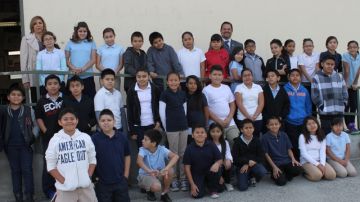Editorial: Historical Memory of Deportation
Yesterday, California governor Jerry Brown took an important step to repair a great injustice

Estudiantes de quinto grado de la primaria Bell Gardens quieren que se estudie el suceso como parte de la historia estadounidense. Crédito: Suministrada | La Opini'on
The year was 1930. The country was drowning in the Great Depression. Millions had lost their jobs and some, their fortunes.
President Herbert Hoover ‒ illegally and violating the Constitution ‒ ordered Mexicans and Mexican-Americans to be deported.
Between 500,000 and two million people were viciously persecuted and seized from the streets of East Los Angeles, on Ash Wednesday, from their humble San Fernando homes, from the shops at La Placita, from their workplaces, from movie theaters, from dance halls. The authorities targeted striking workers or those who were demonstrating against layoffs. Many others, terrorized, fled the country that discriminated against them, losing it all as they left.
The same scene played out in Houston, in San Antonio and throughout the country despite the criticism of La Opinión ‒ already a staple of the Latino community ‒ and many others.
This was the infamous “Mexican Repatriation.” Half of the people expelled illegally, without trial or protections of any kind, had been born here and were U.S. citizens.
After 85 years, the massive deportations were forgotten; school textbooks kept silent about it.
A Republican presidential hopeful, Donald Trump, would rescue the event from oblivion. However, instead of pointing out their cruelty and discriminatory nature, he sees it as a positive example; one that should be repeated.
Trump wants to end birthright citizenship as dictated by the Constitution. He wants to send these children back alongside their parents.
Some, in their ignorance, believe that this is a good idea.
The same way it was justified back then, this atrocity is being defended using the same fallacies: Immigrants take the jobs of the natives; they exhaust the resources; they are “rapists.”
That is why an initiative started by a group of 5th graders from the Bell Gardens primary school, in the Montebello Unified School District in East L.A., is so important. The children submitted a proposal to have our schools teach the history of the Great Deportation.
Assemblywoman Cristina García, who represents the area, took the project to the California Legislature, where it was approved with the majority of votes from both political parties. California Governor Jerry Brown signed the proposal into law yesterday, coinciding with the wave of paranoia and racial hatred that stains the electoral debate.
Bill AB146 decrees that the history of the massive deportation of 1930 will be taught in schools, the same way as the Holocaust and the imprisonment of Japanese-Americans.
Knowledge and our youth’s education are the antidotes to hostility. That is why the initiative of these 5th graders and the action of Assemblywoman García are the best answer to the voices of intolerance that are currently demanding deportations.
Or, as García said: “A certain Republican presidential frontrunner should now see that his unworkable and reckless plan for mass deportation will be a human disaster, just as it was so many years ago. He could learn a lesson from the minds and the hearts of our young school children.”
We salute these children and we congratulate García on her initiative.
















